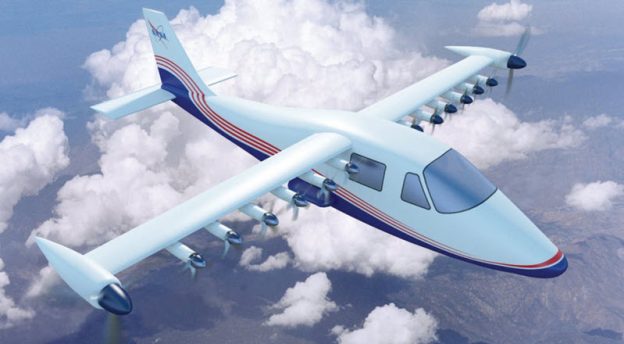NASA is edging nearer to its first flight test for its all-electric experimental „X-plane“ X-57 Maxwell after completing ground tests on the aircraft, a blog post from the space agency reveals. The space agency’s series of X-planes also includes its X-59 QueSST „quiet“ supersonic jet and its hypersonic X-43A scramjet.
The X-57 has made „substantial contributions“ to electric aircraft propulsion
The X-57 program began in 2016 as part of NASA’s Scalable Convergent Electric Propulsion Technology Operations Research Project (SCEPTOR). NASA set out to build a low-emissions aircraft using electric propulsion to test whether such a machine would be viable for commercial transport. The space agency started off by converting an Italian Tecnam P2006T into an electric aircraft, the „Maxwell“, by adding two electric motors made by Joby Aviation in place of the original Rotax engines. „The X-57 project has made substantial contributions to the field of electric aircraft propulsion as an initial pathfinder building a knowledge base of expertise that is influencing industry standards and contributing to future electric vehicle demonstrations,“ said Heather Maliska, X-57 project manager at NASA’s Armstrong Flight Research Center in Edwards, California. The all-electric aircraft has now completed its ground tests meaning it is closer to liftoff. Back in October 2021, NASA announced it would conduct its first crewed flight this year following its ground tests.
Will the X-57 Maxwell prove the viability of electric flight?
The X-57 was designed to have zero in-flight emissions. The aircraft uses a unique high aspect ratio wing design to make it as efficient as possible for electrified flight. However, doubts remain as to whether the results of X-57’s flight tests will lead to commercial flight, or simply help to invigorate the pursuit of other means such as hydrogen aircraft. According to NASA, the X-57 will have a range of about 100 miles and a cruise speed of 172 mph (276 km/h), meaning it will be able to fly for roughly 40 minutes at a time. Though electric cars are set to replace internal combustion engine vehicles in the coming decades, the power required for an aircraft to take off as well as the weight of the large batteries required for aviation means other alternatives are likely required for long-haul airliners. Airbus, for example, is testing a hydrogen engine as well as drop-in fuels on its Airbus A380 model. Nevertheless, NASA aims to push the technology it is built for the X-57 to the limits, and it will also build a hybrid version once the all-electric model has safely taken to the skies. Source: ‚interestingenigneering.com‚.


